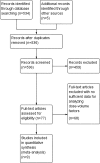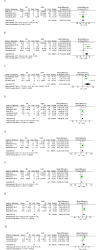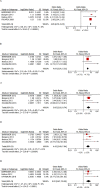Evaluating risk factors of radiation pneumonitis after stereotactic body radiation therapy in lung tumor: Meta-analysis of 9 observational studies
- PMID: 30521600
- PMCID: PMC6283643
- DOI: 10.1371/journal.pone.0208637
Evaluating risk factors of radiation pneumonitis after stereotactic body radiation therapy in lung tumor: Meta-analysis of 9 observational studies
Abstract
Background: In this study, we assessed the association of SBRT (stereotactic body radiotherapy) dose and volume with radiation pneumonitis (RP) risk in lung tumor.
Methods: Relevant articles were identified up to April 2018, using following databases; Medline, EMBASE, Cochrane Library, and China National Knowledge Infrastructure (CNKI). The pooled OR (odds ratio) with 95% CI (confidence interval) data [mean ± SD (standard deviation)] obtained from different studies was analyzed by statistical analysis using a fixed-effects model or a random-effects model when appropriate.
Results: The analysis was based on nine observational studies, which were identified based on the study selection criteria. Between RP and non-RP patients, no difference was observed based on age, but significant differences were observed based on planning target volume (PTV), mean ipsilateral lung dose (MLD), total MLD, and V5, V10, V20 and V40 (the percentage of lung volume exceeding 5, 10, 20 and 40 Gy). In addition, PTV >145 cm3, total MLD ≥4.7 Gy, V5 ≥26.8%, V10 >12% and V20 ≥5.8 were associated with RP risk. Overall, the grade assessments of V5 and V20 revealed moderate quality evidence.
Conclusion: The present study indicated V5 and V20 as major risk factors for RP after SBRT treatment in lung tumor. In addition, it was observed that lung DVH (Dose Volume Histogram) patterns should be assessed more carefully, while predicting RP incidence after SBRT.
Conflict of interest statement
The authors have declared that no competing interests exist.
Figures



References
-
- Blomgren H, Lax I, Naslund I, Svanstrom R. Stereotactic high dose fraction radiation therapy of extracranial tumors using an accelerator. Clinical experience of the first thirty-one patients. Acta Oncol. 1995;34(6):861–70. Epub 1995/01/01. . - PubMed
-
- Roach MC, Videtic GM, Bradley JD, Committee IART. Treatment of Peripheral Non-Small Cell Lung Carcinoma with Stereotactic Body Radiation Therapy. J Thorac Oncol. 2015;10(9):1261–7. 10.1097/JTO.0000000000000610 . - DOI - PubMed
-
- Palma DA, Senan S. Early-stage non-small cell lung cancer in elderly patients: should stereotactic radiation therapy be the standard of care? Int J Radiat Oncol Biol Phys. 2012;84(5):1058–9. Epub 2012/11/13. 10.1016/j.ijrobp.2012.07.2353 . - DOI - PubMed
-
- Mirimanoff RO. Stereotactic ablative body radiotherapy (SABR): an alternative to surgery in stage I-II non-small-cell cancer of the lung? Chinese clinical oncology. 2015;4(4):42 Epub 2016/01/06. 10.3978/j.issn.2304-3865.2015.11.02 . - DOI - PubMed
-
- Aibe N, Yamazaki H, Nakamura S, Tsubokura T, Kobayashi K, Kodani N, et al. Outcome and toxicity of stereotactic body radiotherapy with helical tomotherapy for inoperable lung tumor: analysis of Grade 5 radiation pneumonitis. J Radiat Res. 2014;55(3):575–82. 10.1093/jrr/rrt146 ; PubMed Central PMCID: PMCPMC4014169. - DOI - PMC - PubMed
Publication types
MeSH terms
LinkOut - more resources
Full Text Sources
Medical
Miscellaneous

